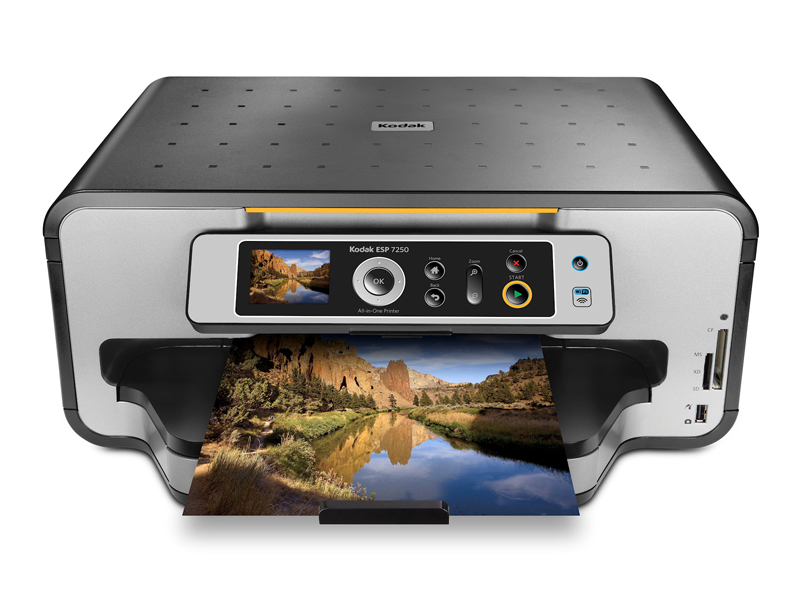TechRadar Verdict
Pros
- +
Well connected with USB, Ethernet and Wi-Fi
- +
Cheap ink costs, unless you use a lot of one particular colour
- +
Automated postcard photo cassette feeder in addition to standard A4 paper input tray
- +
Built-in connectivity options include USB, Ethernet and Wi-Fi
- +
Initial set-up is particularly easy for standalone or network use
Cons
- -
Expensive to buy at twice the price of some competing models
- -
Printing a lot of one colour will offset potential ink cost savings
- -
Photo quality is quite lacklustre, compared with many competing printers
- -
Quite noisy in operation
- -
No direct printing onto CDs or DVDs
Why you can trust TechRadar
According to Kodak's claims, the ESP 7250 can save the average user up to £75 per year on ink, based on a 'typical' annual print volume of 150 6x4-inch photos, 800 text pages and 550 mixed text and colour graphics pages. Or as Kodak's US website puts it, the printer "saves you a ton of money on ink".
That's refreshing news to anyone who's ever bought a cheap inkjet printer, only to find that the cartridges run out a few days later and a replacement set costs almost as much as a whole new printer. But there's nothing cheap about the ESP 7250, which costs twice as much to buy as models like the excellent (though non-Wi-Fi) Canon PIXMA MG5150, or the Wi-Fi enabled Lexmark Interact S605.
Think Kodak and you're probably thinking photos. However, like other current Kodak printers including the ESP 9250 (which includes standalone fax functions), the ESP 7250 is built for general-purpose document printing as well as for photographic output.
There are six inks in all, and while photo printing runs on a five-ink line-up, it's notably different from the typical pigment-based black and dye-based CMYK arrangement used in most Canon printers and the HP Photosmart Premium. In Kodak's case, all the photographic inks are pigment-based.
Keen mathematicians may have noticed that this only adds up to four inks but, because pigment-based inks are notorious for not giving smooth-looking output on glossy paper, the fifth 'ink' is actually a glossy coating.
Sure enough, ink costs can be refreshingly low, especially if you use the high-yield 10XL black cartridge, which is good for about 770 pages of text, as opposed to the 425 pages available from the standard 10B black cartridge supplied with the printer.
This brings mono text page costs down to about 1.6p, which compares favourably with about 2.0p from the HP Photosmart Premium and 2.8p from the latest Canon models such as the iP4850, MG5150 and MG6150.
Sign up for breaking news, reviews, opinion, top tech deals, and more.
A colour 6x4 photo print can cost as little as 20p, including paper, which works out at about half the cost of using one of Canon's latest printers, but there's a catch.
All of the Kodak's colour inks come in one single cartridge, so if you print use one particular colour quite heavily, the life of the combined ink cartridge can be greatly reduced, driving costs up again. That's why the vast majority of new printers from Canon, Epson, HP and Lexmark use individually replaceable cartridges for each colour.
In terms of speed, the ESP 7250 proved a little slow for text pages in our tests at about 18 seconds, although it managed the same speed for colour DTP output, which is more impressive.
6x4 photos took 36 seconds each and a full A4 photo took just over two minutes, making the Kodak pretty quick for photographic printing.
Sadly, however, the actual photo quality was nowhere near as good as on printers such as the Canon MG5150 or MG6150, and lagged quite a way behind the Epson P50 or PX720WD, with washed-out colours and a lack of contrast. There was also a shortage of definition in both highlights and lowlights.
